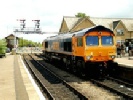Archive Section




By Peter Knottley
An account of the visit to the Shell Haven Oil Refinery and neighbouring Thames Haven British Rail (as then) sidings which were visited by 13 members in June 1990.
The party was welcomed to the oil refinery by Barry Beal, Public Affairs Officer of Shell, and was installed in the administration building round a large model of the complex. Mr Beal gave an interesting and detailed talk on the history and operation of Shell Haven.
The first oil tanks appeared there in 1876 and Shell started in the area about 1909, crude oil refining commencing in 1950 with Middle East oil, which differs from the North Sea variety. The equipment is built to suit the kind of oil and the scale of operations is now vast. From ships the crude is pumped into 100,000-
Butane, methane, petrol, kerosene and gas oil are derived from crude. Each product has a different boiling temperature and (in very simplified terms) in a 200ft tower, having a series of distillation vessels at each of these temperatures the various products are separated and collected. Over 50% of the material remains as a thick, black sediment which is unmarketable although some bitumen is produced from it.
Chemical conversion processes enable valuable products to be obtained from this residue. A “hydrocracker” plant, using a nickel tungsten catalyst, changes its structure to produce almost 100% high octane petrol. Another process, using a “platformer” (platinum catalytic reformer) with a platinum catalyst also refashions the molecules to produce high octane gases (and unleaded petrol).
There followed a minibus tour of the refinery to view the plant and apparatus. It covers 2,000 acres, is 17 miles round the perimeter and has its own generating plant along with emergency and other services. Many short lengths of surviving rail track indicated a former extensive internal system to and between departments.
Next we visited the riverside jetties -
Competition from road and land pipeline has reduced to a low level the quota of products now sent by rail, but the ever-
Finally, Shell territory was left for a visit to neighbouring Thames Haven British Rail sidings, where rested the Railfreight Petroleum exhibition train on the last of its 16 visits to petroleum centres around the country with a “Quality and Safety” message to all staff.
Len Walton, BR Petroleum Contract Manager South East, accompanied a film in the lecture coach with commentary on safety and the national Railfreight Petroleum picture end its future -
A class 37 left on a bitumen trip working whilst this was in progress, and the exhibition train was headed by 47380 “Immingham” (complete with 40B shedplate!) which sported a refurbished cab -
This was an excellent visit and everyone on it is grateful to all who were involved in arranging it, and especially to the four “guides” mentioned who shared their knowledge most courteously and unstintingly.